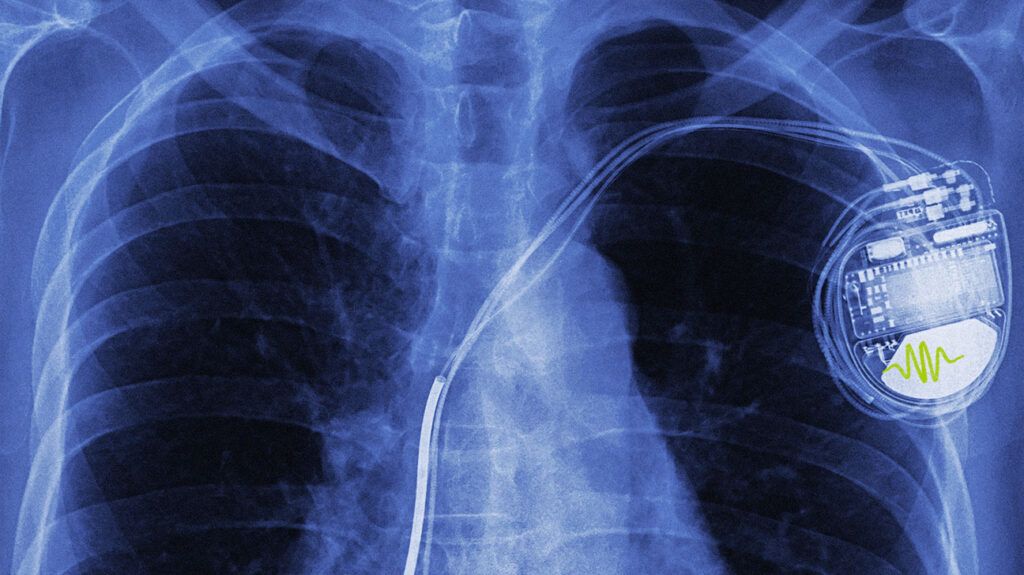A biventricular pacemaker is a device that can help the heart beat more efficiently when a person has heart failure or an irregular heartbeat.
When a person has heart failure or an irregular heartbeat, the heart does not work as efficiently. This can restrict the amount of blood and oxygen reaching the rest of the body.
A biventricular pacemaker is a small device that a surgeon can implant under the skin to help the heart pump more effectively.
This article examines how a biventricular pacemaker works and why a person might need one. It also discusses how a surgeon implants a biventricular pacemaker, the potential risks, and more.

There are two pumps within the heart, each containing two chambers. When a person has heart failure, the heart muscles may weaken, and the bottom chambers may be unable to beat in synchronization. This can cause an irregular heartbeat.
A biventricular pacemaker consists of three leads that a surgeon will place into the top and bottom right chambers and bottom left chamber of the heart.
These leads stimulate the heart by sending an electrical pulse to both lower chambers. A doctor can then adjust the pace of the electrical pulses to ensure that both chambers are synchronized. This allows the blood to pump around the body more effectively.
A doctor
A biventricular pacemaker can assist the heart muscles in a person with heart failure by sending electrical pulses to increase the strength of contractions.
If a person has an irregular heartbeat, the doctor can adjust the electrical pulses of the biventricular pacemaker to ensure both chambers are beating in synchronization.
Before the procedure starts, a surgeon may give a person local anesthetic to numb the area and sedative medication to help them relax.
To implant a biventricular pacemaker, a surgeon
A surgeon will then pass the first lead through a vein into the bottom right chamber of the heart, using an X-ray to guide it. The second lead will pass into the top right chamber and the third into the bottom left chamber.
A surgeon will create a small pocket between the skin and the muscle in the chest area. A surgeon will then connect the leads to the pacemaker generator and place them into the pocket.
Before biventricular pacemaker surgery, a doctor will explain the benefits, risks, and possible complications.
A doctor may advise a person about any medications they should temporarily stop taking.
A person will need to avoid consuming food and liquids for at least
A person may also require blood tests beforehand, particularly if they take blood thinning medication. A doctor can advise on this and any other steps a person may need to take when preparing for biventricular pacemaker surgery.
Following biventricular pacemaker surgery, a person will need to avoid lifting the arm on the same side as the pacemaker for approximately 1 week to avoid displacing any of the leads.
A person should also avoid strenuous exercise or heavy lifting for at least
It is also important to avoid driving during this time.
A person’s doctor can provide them with information about when they will need to attend follow-up appointments and anything else they need to do or avoid following the procedure.
Learn more about recovering from pacemaker surgery.
Several complications may occur following biventricular pacemaker surgery,
- bleeding at the incision site
- blood clots forming in the pacemaker pocket
- infection in the pocket or wound site
- a hole, tear, or cut into the vein
- accumulation of fluid around the heart
- displacement of the pacemaker leads
- collapsed lung, in rare cases
If a person is scheduled to receive a biventricular pacemaker, they can contact their doctor to ask any questions they may have. Their doctor can discuss with them the benefits and risks of the procedure, as well as what to expect before, during, and afterward.
Following the procedure, a person should consider contacting a doctor if they experience any of the following symptoms:
- signs of an infection at the incision site, such as swelling, pain, and fever
- dizziness, shortness of breath, or feeling faint
- fatigue, difficulty breathing, and low blood pressure
- worsening of pain around the pacemaker pocket
- bleeding at the incision site that does not stop when applying pressure
Here are some frequently asked questions about biventricular pacemakers.
What is the difference between a pacemaker and a biventricular pacemaker?
A biventricular pacemaker is a specialized type of pacemaker that has three leads. This means it can control up to three chambers of the heart.
Other types of pacemakers
How long can you live with a biventricular pacemaker?
There is currently no information about how biventricular pacemakers affect life expectancy. However, it typically prolongs a person’s life by treating heart failure, which can otherwise reduce life expectancy.
Is a biventricular pacemaker the same as a CRT-D?
A biventricular pacemaker is not the same as cardiac resynchronization therapy with defibrillator (CRT-D). Both procedures involve helping the heart to beat more effectively. However, CRT-D involves a defibrillator instead of a pacemaker.
A defibrillator is a device that can send an electrical current to the heart to help it beat more regularly. CRT-D can also help prevent the heartbeat from speeding up too much, which a biventricular pacemaker cannot do.
Learn more about the difference between a pacemaker and a defibrillator.
A biventricular pacemaker is a piece of equipment that can help strengthen and regulate the heartbeat when a person has heart failure.
The procedure involves fitting three leads into the chambers of the heart and a small generator device into the chest area.
Once in place, the biventricular pacemaker sends electrical pulses to the heart to help it pump blood around the body more efficiently.
A person may need to rest and avoid heavy lifting for at least 1 week after having biventricular pacemaker surgery.
